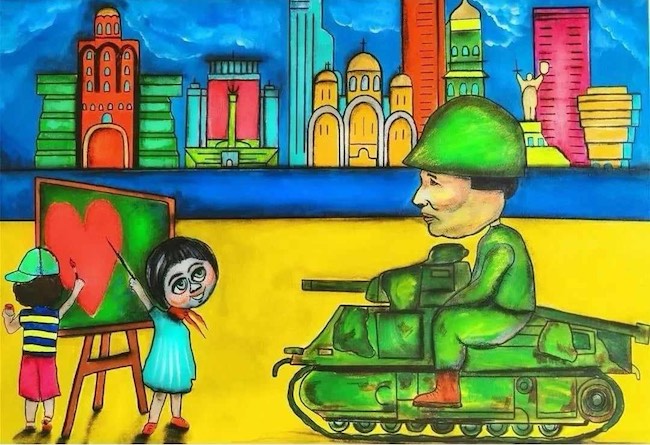Le trasformazioni della realtà osservata portano con sé la straordinaria capacità di aprire la coscienza a un punto di vista privo di ogni formalismo permettendo così di giungere all’essenza, alla natura più vera delle cose o degli individui creando quella spaccatura tra estetica e sostanza che priva il concetto del giudizio, o forse sarebbe meglio dire che lo rende impermeabile alla tendenza contemporanea a restare sulla superficie, a lasciarsi abbagliare dal luccichio della bellezza senza approfondire tutto ciò che sotto la patina si nasconde. Gli artisti che prediligono questo tipo di approccio pittorico riescono a impregnare le loro tele di analisi, di sensazioni e di emozioni che non si curano di come all’esterno le riflessioni possano apparire, bensì vanno dritti all’obiettivo di creare una connessione con l’osservante che si sente dunque attratto da quelle deformazioni intense che toccano le sue corde più profonde. La protagonista di oggi non solo è rappresentante di questo tipo di visione pittorica, ma ne amplia il significato dando origine a uno stile originale e fortemente ironico nella realizzazione visiva che da un lato sembra voler sdrammatizzare ciò che l’occhio osserva, ma dall’altro intende calamitare l’attenzione proprio sull’inutilità di una forma troppo spesso considerata prioritaria.
La caricatura nei tempi più antichi era un modo per sottolineare con sarcasmo i difetti o il desiderio di ridicolizzare personaggi importanti, nobili e imperatori, trasformando le loro peculiarità in deformità fisiche al fine di suscitare ilarità per dissacrarne l’immagine; fu solo nel Cinquecento che questo particolare stile artistico si allontanò dall’accezione iniziale per tendere verso un umorismo più bonario, come rappresentato da Leonardo da Vinci e Albrecht Dürer, divenendo così accettato e accolto come forma d’arte di cui nacquero persino delle scuole sull’intero territorio europeo. Malgrado di fatto la caricatura abbia costituito la base di partenza delle elaborazioni teoriche dei Fauves e degli espressionisti, questo legame è poco frequentemente evidenziato, forse a causa della controversa approvazione che lo stile ebbe nei salotti culturali o forse semplicemente perché essendo prevalentemente realizzato sotto forma di disegno o litografia non era ritenuto all’altezza della pittura tradizionale; tuttavia è inevitabile non pensare alle malformazioni dei personaggi quando si osserva un dipinto di James Ensor, di Oskar Kokoshka, di Evard Munch o di Egon Schiele, artisti che davano la priorità assoluta al sentire, alle paure e alle angosce dell’essere umano di quei tempi e che mettevano in secondo piano ogni ricerca estetica, ogni perfezione formale. I colori, il disegno, la profondità e la prospettiva, tutto era marginale rispetto al messaggio che dalla tela doveva fuoriuscire in maniera inequivocabile, con tutta l’intensità provata dall’esecutore dell’opera e con la forza delle sensazioni meditate e poi concretizzate in figure di cui ciò che doveva emergere era solo il sentire. L’Espressionismo dunque fu un movimento rivoluzionario, irriverente nei confronti delle regole pittoriche accademiche e incurante della possibilità di scandalizzare la benpensante società di quei tempi, tanto quanto la caricatura lo fu negli anni precendenti seppure privata dell’impatto emozionale che invece contraddistinse la corrente pittorica. L’artista tedesca Ditha de Rablo raccoglie l’eredità del passato, prende spunto dalle deformazioni, dalle distorzioni formali dei caricaturisti arricchendole con l’ampia gamma cromatica, irreale e decontestualizzata che aveva contraddistinto le linee guida dell’Espressionismo, aggiungendo però un ulteriore elemento, quello di una noncuranza snob nei confronti di tutte quelle regole non scritte della società attuale secondo cui è necessario rispondere a modelli estetici e formali, quello del rinunciare completamente alla piacevolezza esteriore per mostrare la superiorità dell’animo, di quell’universo interiore in grado di orientarsi verso il nocciolo delle cose piuttosto che galleggiare sopra una superficie patinata che non lascia spazio a null’altro che l’involucro.
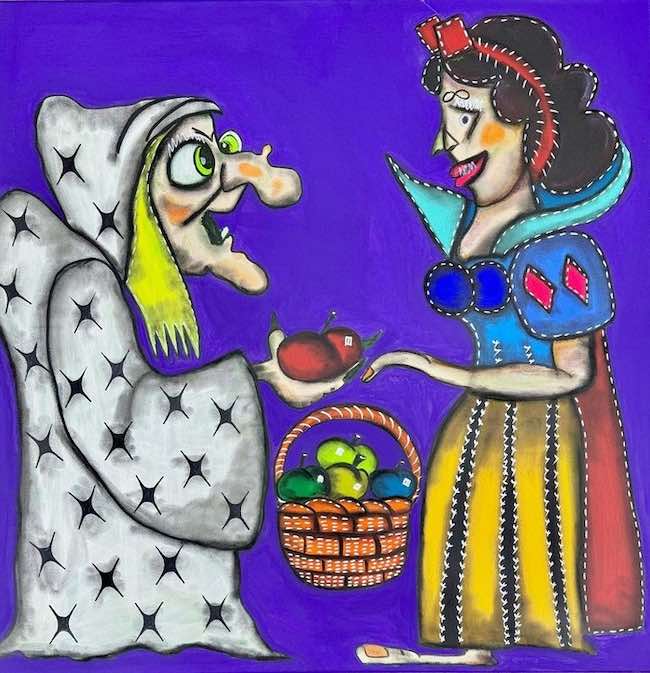
Questo tipo di atteggiamento esistenziale ma anche artistico che caratterizza la produzione di Ditha de Rablo prende il nome di Gagaismo e incarna perfettamente l’atteggiamento nei confronti della realtà osservata e del concetto di vita che appartiene all’artista e che al tempo stesso punta a sensibilizzare il fruitore sull’importanza di essere se stesso a prescindere dall’aspetto esterno, senza preoccuparsi di apparire meno perfetto, meno impeccabile, più vulnerabile ma incredibilmente più vero e autentico. I colori della de Rablo sono sempre intensi, vivi, solari, luminosi, anche quando le scene descritte raccontano di momenti tristi, bui, pericolosi, quasi a voler enfatizzare quanto l’atteggiamento possa fare la differenza persino sull’evolversi della realtà, delle circostanze apparentemente inevitabili; le distorsioni dei volti dei suoi protagonisti li avvicina al mondo del fumetto, quello più ironico e derisorio, anche laddove il tema trattato è invece rilevante o grave.
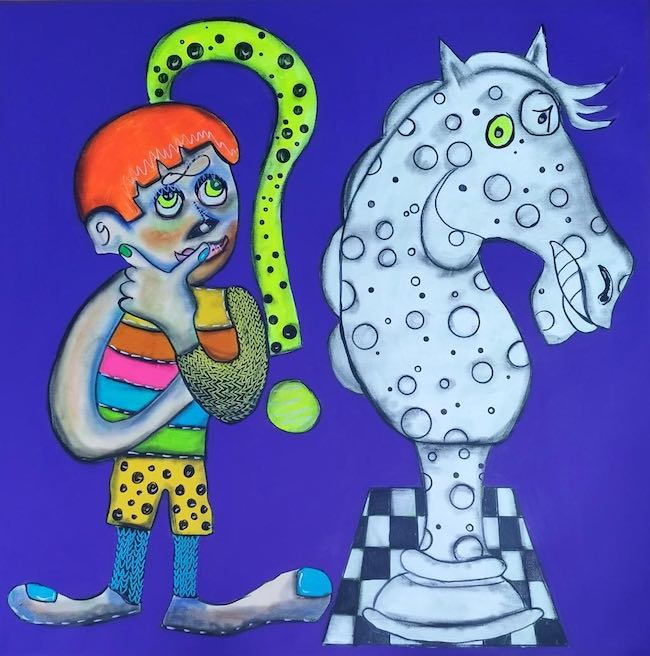
Ecco quindi che il Gagaismo perde l’accezione negativa abitualmente attribuita al gagà, quella cioè di fingere eleganza e ricercatezza pur essendone privo, e si sposta piuttosto sulla ricerca dell’equilibrio tra necessità di affrontare temi esistenziali seri e un aspetto leggero delle sue tele, confermando l’attitudine ad attrarre lo sguardo attraverso la semplicità espressiva per poi condurre a una riflessione sui significati eliminando così la tentazione di rimanere in quella superficie che Ditha de Rablo rifugge per indole personale e creativa. La più recente produzione affronta tre temi su cui l’artista ha a lungo meditato e che l’hanno condotta alla necessità di approfondimento soprattutto a causa degli eventi che si sono susseguiti negli ultimi tre anni.
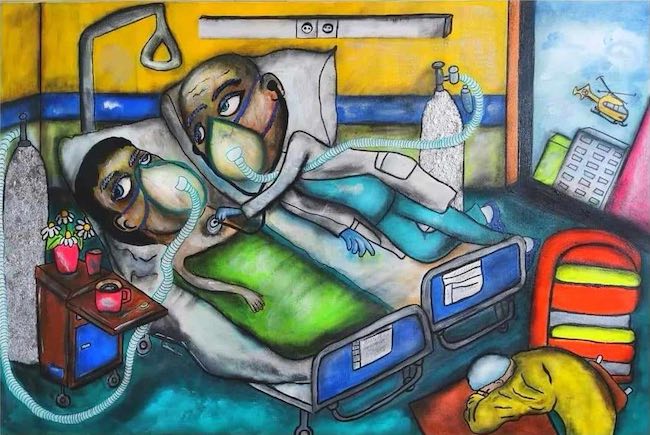
In Medici senza frontiere ripercorre il lungo periodo della pandemia che ha non solo messo a rischio la salute delle persone ma ha anche letteralmente distrutto le economie dei paesi del mondo; l’accento è puntato sull’eroismo di molti medici che in quel periodo hanno sacrificato la propria vita privata, hanno rinunciato a salvaguardare se stessi pur di assolvere al compito scelto per vocazione, quello cioè di salvare vite umane. All’interno della stanza di ospedale pone due lettini, uno con un paziente e uno con un medico, entrambi malati e necessitanti ossigeno eppure il medico non perde mai di vista il malato, come se la vita del secondo fosse quasi prioritaria rispetto alla propria; malgrado il momento drammatico ciò che colpisce della tela è la luminosità dei colori, il cielo sereno fuori che rappresenta la speranza.
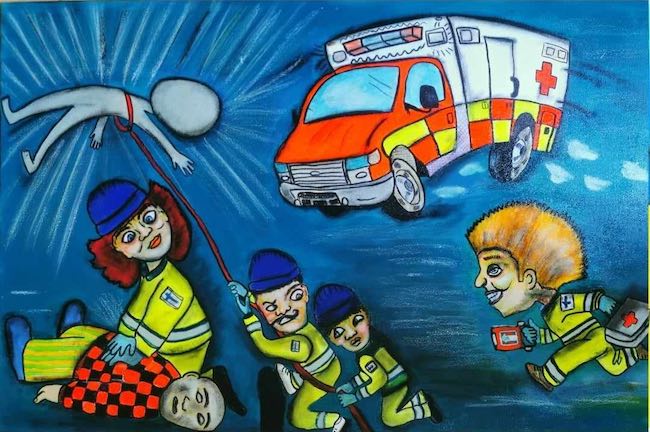
Nell’opera Angeli del salvataggio Ditha de Rablo mette in evidenza il lavoro dei paramedici, degli addetti al primo soccorso che di fatto sono coloro i quali riescono a trattenere, esattamente come dall’immagine sulla tela in cui due di loro trattengono a terra con una corda l’anima dell’uomo, la vita a discapito della morte; il ruolo di questi uomini e donne è fondametale, loro stessi devono ogni giorno, in ogni intervento, rinunciare alle proprie paure, dominare le proprie emozioni perché è proprio dalla capacità di mantenere il sangue freddo che dipende la sopravvivenza delle persone che soccorrono.
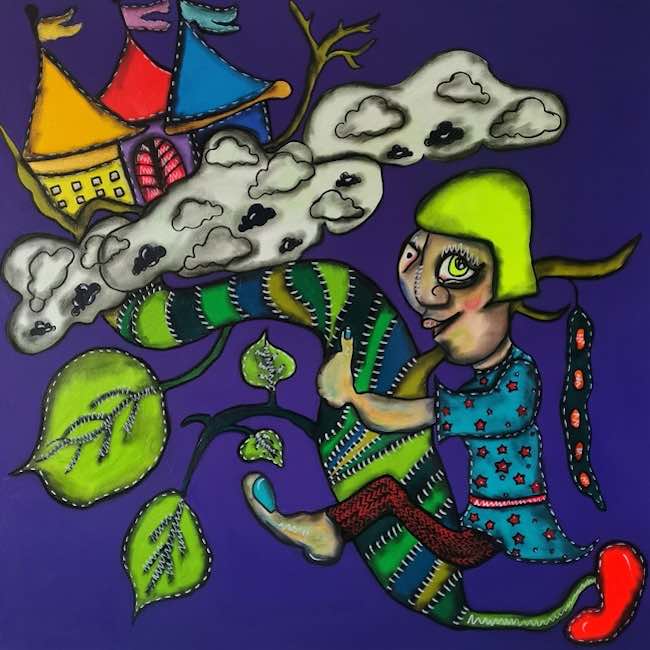
Le opere della serie La stanza dei bambini perduti appartengono invece a una riflessione compiuta dall’artista a seguito della perdita improvvisa di un amico che aveva scritto un romanzo che aveva le potenzialità di diventare un best-seller ma che non ha mai provato a pubblicare, così il pensiero della de Rablo è andato a tutti quei sogni, quei desideri espressi da piccoli che poi però vengono persi nell’età adulta, un po’ per paura di fallire, un po’ per la convinzione di non dover perseguire ciò che è impossibile bensì credere solo in ciò che è possibile.
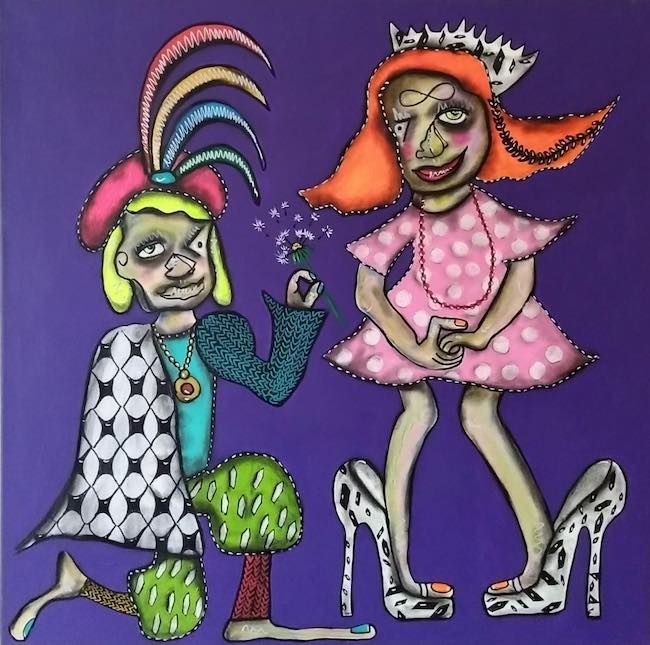
Dunque nelle opere appartenenti a questa produzione l’artista esplora le fiabe o le stanze relegate dentro a quel mondo infantile in cui ai bambini è stato insegnato a considerare i sogni solo come favole da lasciarsi indietro crescendo, dimenticando così il lato più spontaneo di sé, che però coincide con quello più coraggioso, con quello convinto che anche l’improbabile possa divenire raggiungibile.
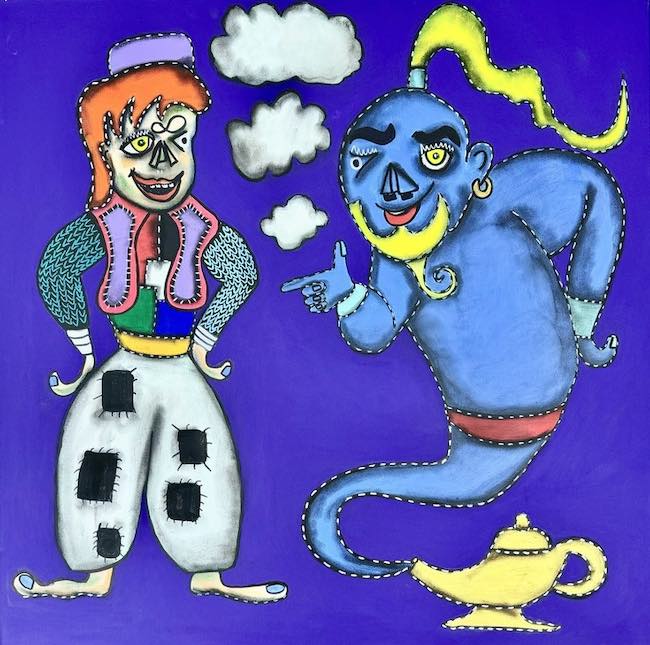
In queste opere a volte sono protagonisti i personaggi dei cartoni animati, altre invece semplicemente atteggiamenti dei bambini che si aggirano spensierati e audaci nel loro mondo immaginario dentro cui riescono a conquistare una felicità totale e appagante proprio perché costituita di piccole cose e della fiducia verso il futuro. Ditha de Rablo ha esposto le sue opere, riscuotendo successi e premi, in Italia, a New York, al Museo Meom di Barcellona e ha preso parte alla mostra di Yoko Ono Peace is power al Museo di Lipsia.
DITHA DE RABLO-CONTATTI
Email: info@rabio.email
Sito web: www.saatchiart.com/account/artworks/1284461
Facebook: www.facebook.com/dithaderablo
Linkedin: www.linkedin.com/in/ditha-de-rablo-2b4949172/
Instagram: www.instagram.com/ditha_de_rablo/
Reflections and considerations on the human being in the visual distortions of Gagaism by Ditha de Rablo
The transformations of observed reality bring with them the extraordinary capacity to open the consciousness to a point of view devoid of all formalism, thus allowing us to reach the essence, the truest nature of things or individuals, creating that rift between aesthetics and substance that deprives the concept of judgement, or perhaps it would be better to say that it makes it impervious to the contemporary tendency to remain on the surface, to be dazzled by the glitter of beauty without delving into all that is hidden beneath the veneer. The artists who favour this type of pictorial approach succeed in imbuing their canvases with analysis, sensations and emotions that do not care how the reflections may appear on the outside, but rather go straight to the goal of creating a connection with the observer who thus feels drawn to those intense deformations that touch his deepest chords. Today’s protagonist is not only representative of this type of pictorial vision, but expands its meaning, giving rise to an original and highly ironic style of visual realisation that on the one hand seems to want to play down what the eye observes, but on the other intends to draw attention precisely to the uselessness of a form that is too often considered a priority.
In the earliest times, caricature was a way of sarcastically emphasising flaws or the desire to ridicule important figures, nobles and emperors, transforming their peculiarities into physical deformities in order to arouse hilarity and desecrate their image; it was only in the 16th century that this particular artistic style moved away from its initial meaning and tended towards a more good-natured humour, as represented by Leonardo da Vinci and Albrecht Dürer, thus becoming accepted and embraced as an art form of which even sprang up schools all over Europe. Although caricature did in fact form the basis for the theoretical elaborations of the Fauves and Expressionists, this link is seldom highlighted, perhaps because of the controversial approval the style had in cultural salons or perhaps simply because being predominantly realised in the form of a drawing or lithograph it was not considered equal to traditional painting; nevertheless, it is inevitable not to think of the malformations of the characters when one observes a painting by James Ensor, Oskar Kokoshka, Evard Munch or Egon Schiele, artists who gave absolute priority to the feelings, fears and anxieties of the human being of those times and who put all aesthetic research, all formal perfection, in second place. Colours, drawing, depth and perspective, everything was marginal in relation to the message that had to come out of the canvas unequivocally, with all the intensity felt by the executor of the artwork and with the strength of the sensations meditated upon and then concretised in figures of which only the feeling had to emerge. Expressionism, therefore, was a revolutionary movement, irreverent towards the rules of academic painting and unconcerned about the possibility of scandalising the well-meaning society of the time, as much as caricature had been in the preceding years, albeit deprived of the emotional impact that characterised the pictorial current.
The German artist Ditha de Rablo picks up the legacy of the past, taking her cue from the deformations, the formal distortions of the caricaturists, enriching them with the wide, unreal and decontextualised chromatic range that had distinguished the guidelines of Expressionism, but adding a further element, that of a snobbish nonchalance towards all those unwritten rules of today’s society according to which it is necessary to respond to aesthetic and formal models, that of completely renouncing external pleasantness in order to show the superiority of the soul, of that inner universe capable of orienting itself towards the core of things rather than floating above a glossy surface that leaves no room for anything but the shell. This type of existential but also artistic attitude that characterises Ditha de Rablo‘s production is called Gagaism and perfectly embodies the attitude towards observed reality and the concept of life that belongs to the artist, while at the same time aiming to make the viewer aware of the importance of being oneself regardless of one’s external appearance, without worrying about appearing less perfect, less impeccable, more vulnerable but incredibly more true and authentic. De Rablo‘s colours are always intense, vivid, bright, even when the scenes described tell of sad, dark, dangerous moments, almost as if to emphasise how much attitude can make a difference even on the evolution of reality, of apparently inevitable circumstances; the distortions of her protagonists’ faces bring them closer to the world of comics, the more ironic and derisive one, even when the subject matter is instead relevant or serious.
Thus, Gagaism loses the negative meaning usually attributed to gaga, that of feigning elegance and refinement while lacking it, and shifts instead to the search for a balance between the need to address serious existential themes and the light aspect of her canvases, confirming her aptitude for attracting the eye through expressive simplicity and then leading to a reflection on meanings, thus eliminating the temptation to remain on that surface that Ditha de Rablo shuns by her personal and creative nature. The most recent production deals with three themes on which the artist has long meditated and which have led her to the need for in-depth study, especially due to the events that have taken place over the last three years. In Doctors Without Borders, she traces the long period of the pandemic that not only put people’s health at risk but also literally destroyed the economies of countries around the world; the accent is on the heroism of many doctors who sacrificed their private lives during that period, who gave up their lives to safeguard themselves in order to fulfil their chosen vocation, that of saving lives. Inside the hospital room she places two couches, one with a patient and one with a doctor, both sick and in need of oxygen, yet the doctor never loses sight of the sick man, as if the life of the latter were almost a priority over his own; despite the dramatic moment, what is striking about the canvas is the brightness of the colours, the clear sky outside representing hope.
In the artwork Angels of Rescue, Ditha de Rablo emphasises the job of the paramedics, the first-aid workers who are in fact those who manage to hold back, exactly as in the image on the canvas in which two of them hold the man’s soul to the ground with a rope, life at the expense of death; the role of these men and women is fundamental, they must every day, in every intervention, renounce their fears, dominate their emotions because it is on the ability to keep a cool head that the survival of the people they rescue depends. The paintings in the series The Room of the Lost Children belong instead to a reflection made by the artist following the sudden loss of a friend who had written a novel that had the potential to become a best-seller but which he never tried to publish, so de Rablo‘s thoughts went to all those dreams, those desires expressed as children that are then lost in adulthood, partly out of fear of failure, partly out of a conviction not to pursue what is impossible but to believe only in what is possible. Thus, in the works belonging to this production, the artist explores the fairy tales or rooms relegated within that childish world in which children have been taught to consider dreams only as fairy tales to be left behind as they grow up, thus forgetting the more spontaneous side of themselves, which however coincides with the more courageous one, with the one convinced that even the improbable can become attainable. In these paintings, sometimes cartoon characters are the protagonists, at others simply the attitudes of children who wander carefree and daring in their imaginary world within which they manage to conquer a total and fulfilling happiness precisely because it consists of small things and trust in the future. Ditha de Rablo has exhibited her artworks, gaining success and awards, in Italy, in New York, at the Meom Museum in Barcelona and took part in Yoko Ono‘s exhibition Peace is power at the Leipzig Museum.


